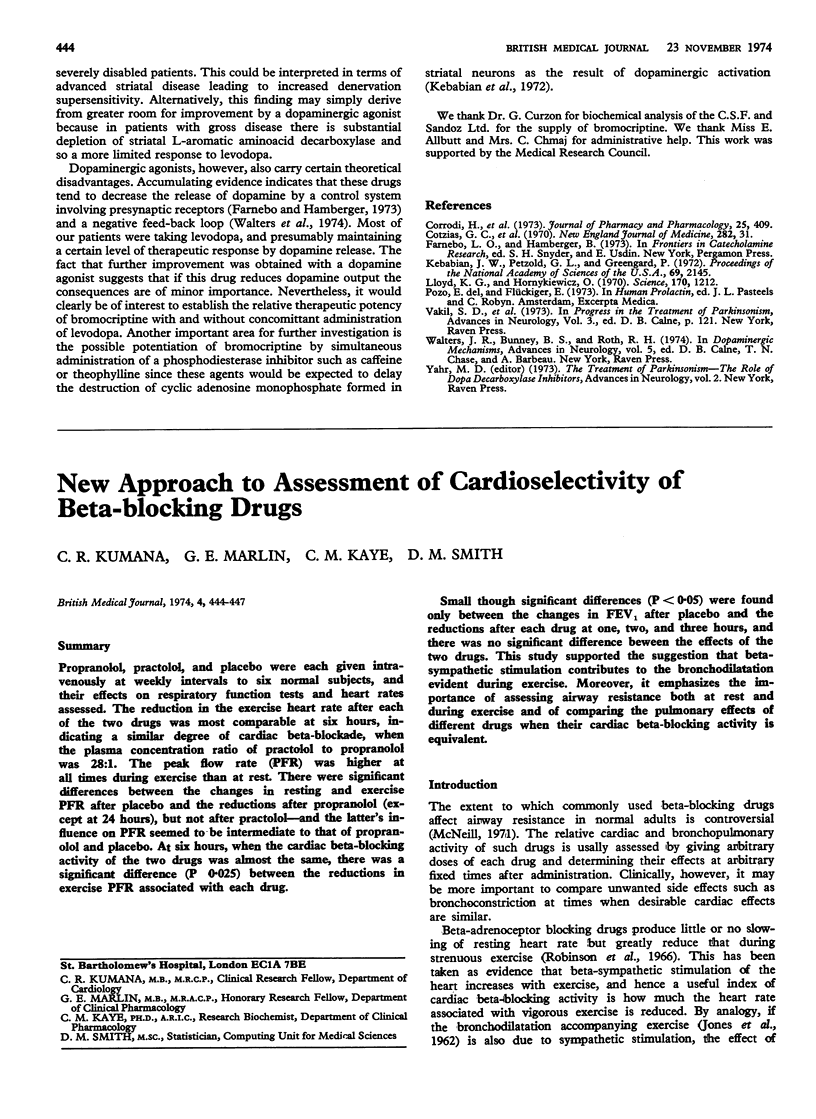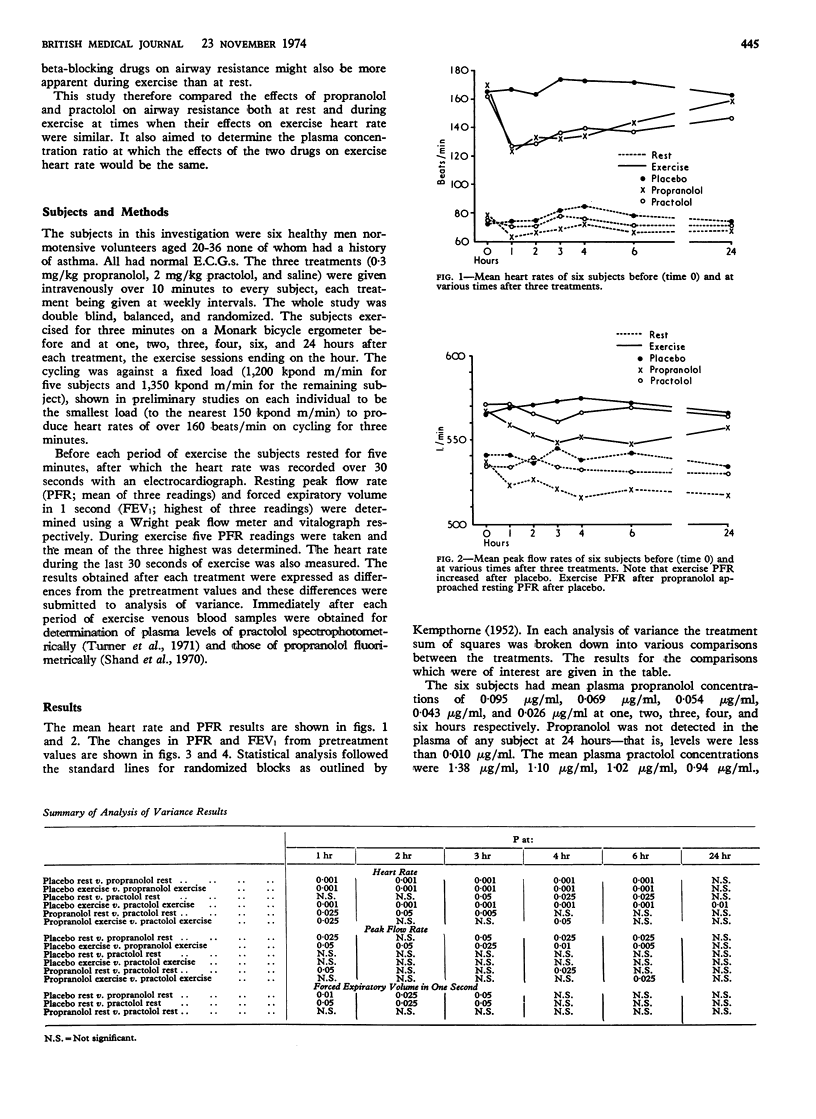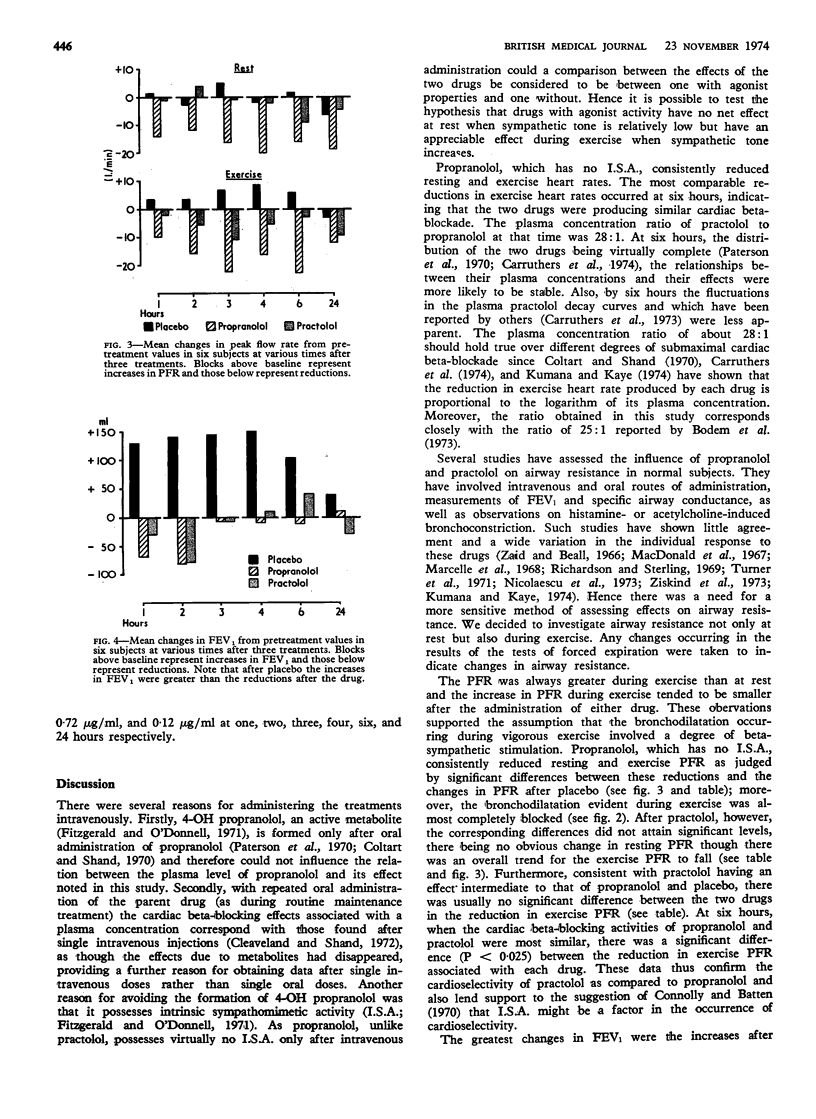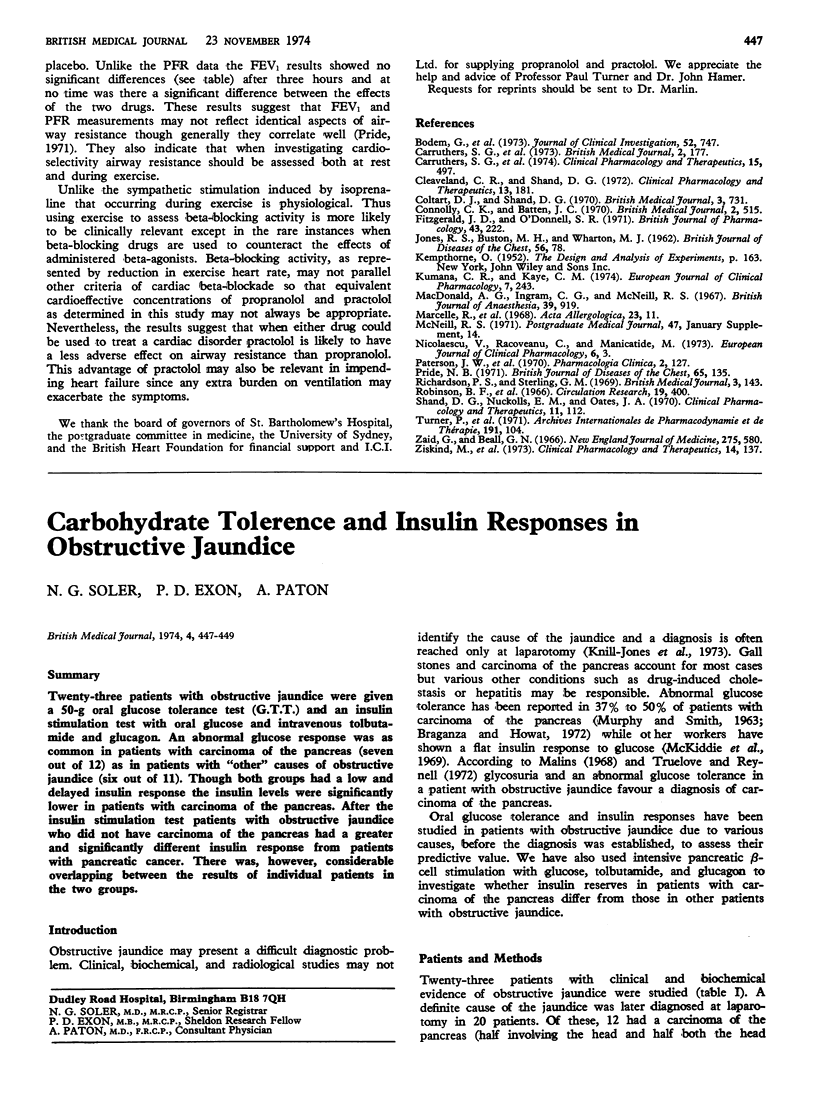Abstract
Propranolol, practolol, and placebo were each given intravenously at weekly intervals to six normal subjects, and their effects on respiratory function tests and heart rates assessed. The reduction in the exercise heart rate after each of the two drugs was most comparable at six hours, indicating a similar degree of cardiac beta-blockade, when the plasma concentration ratio of practolol to propranolol was 28:1. The peak flow rate (PFR) was higher at all times during exercise than at rest. There were significant differences between the changes in resting and exercise PFR after placebo and the reductions after propranolol (except at 24 hours), but not after practolol—and the latter's influence on PFR seemed to be intermediate to that of propranolol and placebo. At six hours, when the cardiac beta-blocking activity of the two drugs was almost the same, there was a significant difference (P 0·025) between the reductions in exercise PFR associated with each drug.
Full text
PDF



Selected References
These references are in PubMed. This may not be the complete list of references from this article.
- Bodem G., Brammell H. L., Weil J. V., Chidsey C. A. Pharmacodynamic studies of beta adrenergic antagonism induced in man by propranolol and practolol. J Clin Invest. 1973 Apr;52(4):747–754. doi: 10.1172/JCI107237. [DOI] [PMC free article] [PubMed] [Google Scholar]
- Carruthers S. G., Kelly J. G., McDevitt D. G., Shanks R. G. Blood levels of practolol after oral and parenteral administration and their relationship to exercise heart rate. Clin Pharmacol Ther. 1974 May;15(5):497–509. doi: 10.1002/cpt1974155497. [DOI] [PubMed] [Google Scholar]
- Carruthers S. G., Kelly J. G., McDevitt D. G., Shanks R. G., Walsh M. J. Duration of action of beta-blocking drugs. Br Med J. 1973 Apr 21;2(5859):177–177. doi: 10.1136/bmj.2.5859.177-a. [DOI] [PMC free article] [PubMed] [Google Scholar]
- Cleaveland C. R., Shand D. G. Effect of route of administration on the relationship between -adrenergic blockade and plasma propranolol level. Clin Pharmacol Ther. 1972 Mar-Apr;13(2):181–185. doi: 10.1002/cpt1972132181. [DOI] [PubMed] [Google Scholar]
- Coltart D. J., Shand D. G. Plasma propranolol levels in the quaniitative assessment of beta-adrenergic blockade in man. Br Med J. 1970 Sep 26;3(5725):731–734. doi: 10.1136/bmj.3.5725.731. [DOI] [PMC free article] [PubMed] [Google Scholar]
- Connolly C. K., Batten J. C. Comparison of the effect of alprenolol and propranolol on specific airway conductance in asthmatic subjects. Br Med J. 1970 May 30;2(5708):515–516. doi: 10.1136/bmj.2.5708.515. [DOI] [PMC free article] [PubMed] [Google Scholar]
- Fitzgerald J. D., O'Donnell S. R. Pharmacology of 4-hydroxypropranolol, a metabolite of propranolol. Br J Pharmacol. 1971 Sep;43(1):222–235. doi: 10.1111/j.1476-5381.1971.tb07171.x. [DOI] [PMC free article] [PubMed] [Google Scholar]
- JONES R. S., BUSTON M. H., WHARTON M. J. The effect of exercise on ventilatory function in the child with asthma. Br J Dis Chest. 1962 Apr;56:78–86. doi: 10.1016/s0007-0971(62)80005-9. [DOI] [PubMed] [Google Scholar]
- Kumana C. R., Kaye C. M. An investigation of the relationship between beta-adrenoceptor blockade and plasma practolol concentration in man. Eur J Clin Pharmacol. 1974 Jul 26;7(4):243–248. doi: 10.1007/BF00560338. [DOI] [PubMed] [Google Scholar]
- Macdonald A. G., Ingram C. G., McNeill R. S. The effect of propranolol on airway resistance. Br J Anaesth. 1967 Dec;39(12):919–926. doi: 10.1093/bja/39.12.919. [DOI] [PubMed] [Google Scholar]
- Marcelle R., Bottin R., Juchmes J., Lecomte J. Réactions bronchomotrices de l'homme sain après blocage des récepteurs beta-adrénergiques. Acta Allergol. 1968 Feb;23(1):11–17. [PubMed] [Google Scholar]
- Pride N. B. The assessment of airflow obstruction. Role of measurements of airways resistance and of tests of forced expiration. Br J Dis Chest. 1971 Jul;65:135–169. doi: 10.1016/0007-0971(71)90018-0. [DOI] [PubMed] [Google Scholar]
- Richardson P. S., Sterling G. M. Effects of beta-adrenergic receptor blockade on airway conductance and lung volume in normal and asthmatic subjects. Br Med J. 1969 Jul 19;3(5663):143–145. doi: 10.1136/bmj.3.5663.143. [DOI] [PMC free article] [PubMed] [Google Scholar]
- Robinson B. F., Epstein S. E., Beiser G. D., Braunwald E. Control of heart rate by the autonomic nervous system. Studies in man on the interrelation between baroreceptor mechanisms and exercise. Circ Res. 1966 Aug;19(2):400–411. doi: 10.1161/01.res.19.2.400. [DOI] [PubMed] [Google Scholar]
- Shand D. G., Nuckolls E. M., Oates J. A. Plasma propranolol levels in adults with observations in four children. Clin Pharmacol Ther. 1970 Jan-Feb;11(1):112–120. doi: 10.1002/cpt1970111112. [DOI] [PubMed] [Google Scholar]
- Turner P., Burman J., Hicks D. C., Cherrington N. K., MacKinnon J., Wallet T., Woolnough M. A comparison of the effects of propranolol and practolol on forced expiratory volume and resting heart rate in normal subjects. Arch Int Pharmacodyn Ther. 1971 May;191(1):104–110. [PubMed] [Google Scholar]
- Zaid G., Beall G. N. Bronchial response to beta-adrenergic blockade. N Engl J Med. 1966 Sep 15;275(11):580–584. doi: 10.1056/NEJM196609152751103. [DOI] [PubMed] [Google Scholar]


